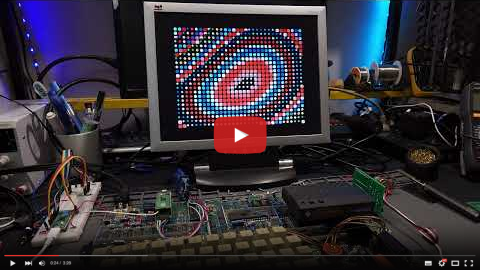TMS9918 emulator. Core engine written in C99. Zero dependencies.
The goal is to emulate all documented modes listed in the TMS9918A/TMS9928A/TMS9929A datasheet
- Graphics I (including sprites)
- Graphics II (including sprites)
- Multicolor mode (including sprites)
- Text
- 5th sprite
- Sprite collisions
- VSYNC interrupt
- Individual scanline rendering
This library is also being used in the PICO9918 project. A drop-in replacement for a physical TMS9918A powered by a Raspberry Pi Pico.
The PICO9918 running in an original TI-99/4A:
See github.com/visrealm/pico9918
vrEmuTms9918 uses the CMake build system
git clone https://github.com/visrealm/vrEmuTms9918.git
cd vrEmuTms9918
mkdir build
cd build
cmake ..
cmake --build .
Windows: Optionally, open the generated solution file
ctest
Windows: Optionally, build the ALL_TESTS project in the generated solution file
#include "vrEmuTms9918.h"
#include "vrEmuTms9918Util.h"
#define TMS_VRAM_NAME_ADDRESS 0x3800
#define TMS_VRAM_COLOR_ADDRESS 0x0000
#define TMS_VRAM_PATT_ADDRESS 0x2000
#define TMS_VRAM_SPRITE_ATTR_ADDRESS 0x3B00
#define TMS_VRAM_SPRITE_PATT_ADDRESS 0x1800
// program entry point
int main()
{
// create a new tms9918
VrEmuTms9918 *tms9918 = vrEmuTms9918New();
// Here, we're using the helper functions provided by vrEmuTms9918Util.h
//
// In a full system emulator, the only functions required (connected to the system bus) would be:
//
// * vrEmuTms9918WriteAddr()
// * vrEmuTms9918WriteData()
// * vrEmuTms9918ReadStatus()
// * vrEmuTms9918ReadData()
//
// The helper functions below wrap the above functions and are not required.
// vrEmuTms9918Util.h/c can be omitted if you're not using them.
//
// For a full example, see https://github.com/visrealm/hbc-56/blob/master/emulator/src/devices/tms9918_device.c
// set up the VDP write-only registers
vrEmuTms9918WriteRegisterValue(tms9918, TMS_REG_0, TMS_R0_MODE_GRAPHICS_I);
vrEmuTms9918WriteRegisterValue(tms9918, TMS_REG_1, TMS_R1_MODE_GRAPHICS_I | TMS_R1_RAM_16K);
vrEmuTms9918SetNameTableAddr(tms9918, TMS_VRAM_NAME_ADDRESS);
vrEmuTms9918SetColorTableAddr(tms9918, TMS_VRAM_COLOR_ADDRESS);
vrEmuTms9918SetPatternTableAddr(tms9918, TMS_VRAM_PATT_ADDRESS);
vrEmuTms9918SetSpriteAttrTableAddr(tms9918, TMS_VRAM_SPRITE_ATTR_ADDRESS);
vrEmuTms9918SetSpritePattTableAddr(tms9918, TMS_VRAM_SPRITE_PATT_ADDRESS);
vrEmuTms9918SetFgBgColor(tms9918, TMS_BLACK, TMS_CYAN);
// send it some data (a pattern)
vrEmuTms9918SetAddressWrite(tms9918, TMS_VRAM_PATT_ADDRESS);
// update pattern #0
char smile[] = {0b00111100,
0b01000010,
0b10000001,
0b10100101,
0b10000001,
0b10011001,
0b01000010,
0b00111100};
vrEmuTms9918WriteBytes(tms9918, smile, sizeof(smile));
// update fg/bg color for first 8 characters
vrEmuTms9918SetAddressWrite(tms9918, TMS_VRAM_COLOR_ADDRESS)
vrEmuTms9918WriteData(tms9918, vrEmuTms9918FgBgColor(TMS_BLACK, TMS_LT_YELLOW));
// output smile pattern to screen
vrEmuTms9918SetAddressWrite(tms9918, TMS_VRAM_NAME_ADDRESS);
// a few smiles
vrEmuTms9918WriteData(tms9918, 0x00);
vrEmuTms9918WriteData(tms9918, 0x00);
vrEmuTms9918WriteData(tms9918, 0x00);
// render the display
char scanline[TMS9918A_PIXELS_X]; // scanline buffer
// an example output (a framebuffer for an SDL texture)
uint32_t frameBuffer[TMS9918A_PIXELS_X * TMS9918A_PIXELS_Y];
// generate all scanlines and render to framebuffer
uint32_t *pixPtr = frameBuffer;
for (int y = 0; y < TMS9918A_PIXELS_Y; ++y)
{
// get the scanline pixels
vrEmuTms9918ScanLine(tms9918, y, scanline);
for (int x = 0; x < TMS9918A_PIXELS_X; ++x)
{
// values returned from vrEmuTms9918ScanLine() are palette indexes
// use the vrEmuTms9918Palette array to convert to an RGBA value
*pixPtr++ = vrEmuTms9918Palette[scanline[x]];
}
}
// output the buffer...
...
// clean up
vrEmuTms9918Destroy(tms9918);
tms9918 = NULL;
return 0;
}This library is used in the HBC-56 emulator.
The HBC-56 uses this library to support:
- Rendering to an SDL texture.
- TMS9918 VSYNC Interrupts.
- Time-based rendering. Supports beam-time.
Full source: hbc-56/emulator/src/devices/tms9918_device.c
This code is licensed under the MIT license




